How to Fix Stretched Succulents + Why They Grow Leggy
Are you wondering why succulents grow leggy or stretch out of shape? It’s no surprise that fans of succulents love the compact shape of these beautiful plants.
We all love those lovely Echevarrias that look like perfect roses at the garden centers, don’t we?!? So when they start to become leggy and lose their rose-like shape, it can feel both frustrating and discouraging.
If you’ve watched this happen to your succulents you might be wondering if anything can be done about it. This guide will teach you how to prevent succulents from becoming leggy and how to fix a stretched-out succulent.
But first – let’s get something clear. You might be wondering whether your plant is dying because it’s stretching out or growing long stems.
Well, here’s the good news: your plant is NOT going to die just because it grew tall and leggy. But it does mean it’s not getting what it needs.
Thankfully, leggy succulents are preventable and I’ll show you what they need in order to retain their shape, especially new rosettes. Here’s a clue: it has to do with light! Let me explain.
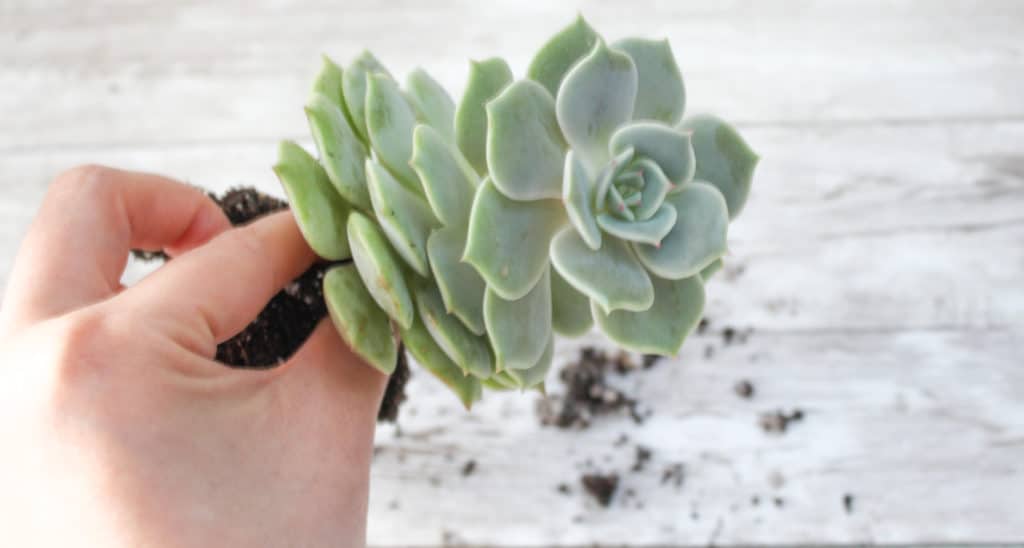
What is Etiolation?
Ahhh – the dreaded etiolation process. It’s something succulent growers need to be aware of.
Succulent etiolation simply refers to the process in which succulents, in search of more light, literally stretch themselves toward the nearest light source. Think of it as your plant’s natural survival instinct.
Succulents need light to survive and their ideal amount is 6 hours of indirect sunlight. If they’re not getting that, they’ll slowly grow tall or out towards the light. Also, echeverias usually need direct sunlight to stay their compact shape. I’ve noticed that indirect or filtered sunlight isn’t always enough.
Indoor plants usually suffer the most because of a lack of sunlight available indoors. This is when a grow light would prove invaluable. I know this isn’t always practical, however, depending upon where you’re displaying your succulents.
Also, if you want to see new growth on your plants, they need enough light! Insufficient sunlight will keep your succulent plants from gaining color and growing new leaves or stronger root systems.
Head over to this post if you’d like to look at a list of the Best Succulent Plants for Indoors, along with photos.
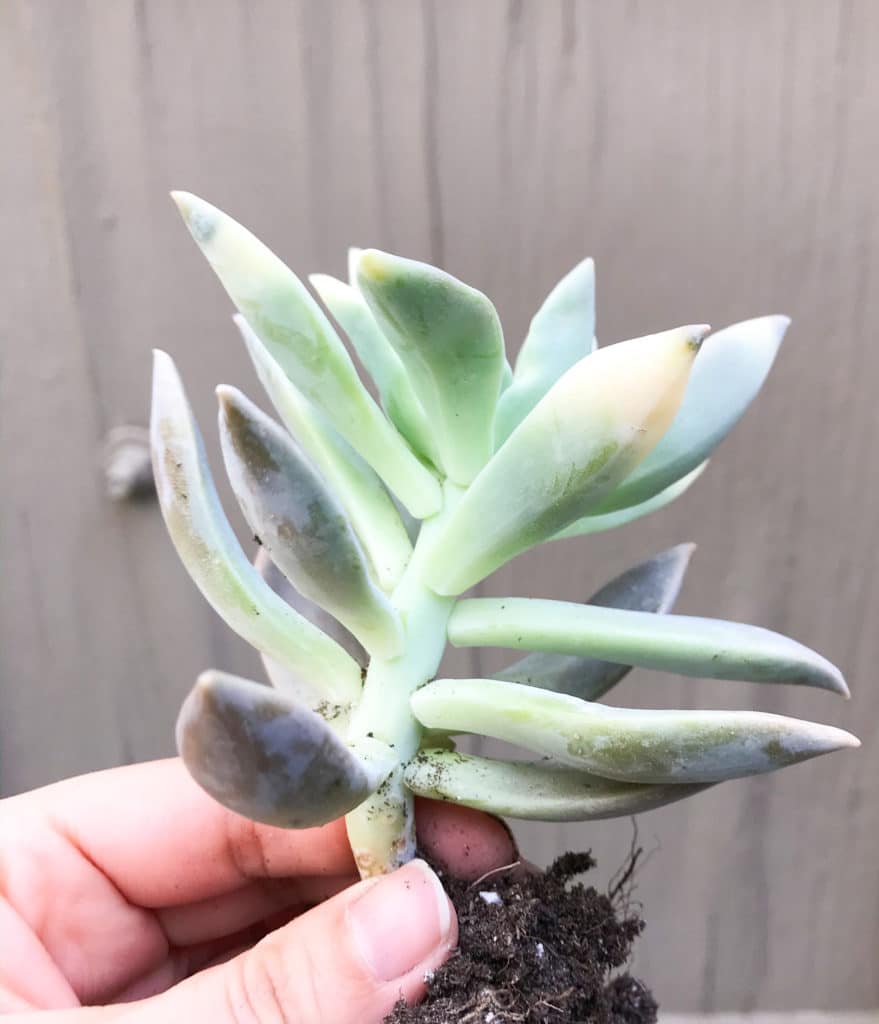
Another main reason that causes succulents to stretch is fertilizer application. Etiolation can happen when you give your succulent a dose of fertilizer but not enough sunlight.
Fertilizer helps succulents grow faster, so if they’re forced to grow in a short amount of time but don’t have adequate sunlight, they’ll stretch out quickly.
Before you know it, you’ll notice large gaps on the stem between each leaf. You’ll see leggy growth and an etiolated succulent that doesn’t look like the compact plant it once was.
Succulents actually don’t need fertilizer – they can live without it. But if you choose to fertilize, keep in mind they’ll need a full day of direct sunlight while they’re in the growing phase. For more on fertilizing, you can read a guide at How to Fertilize Succulents.
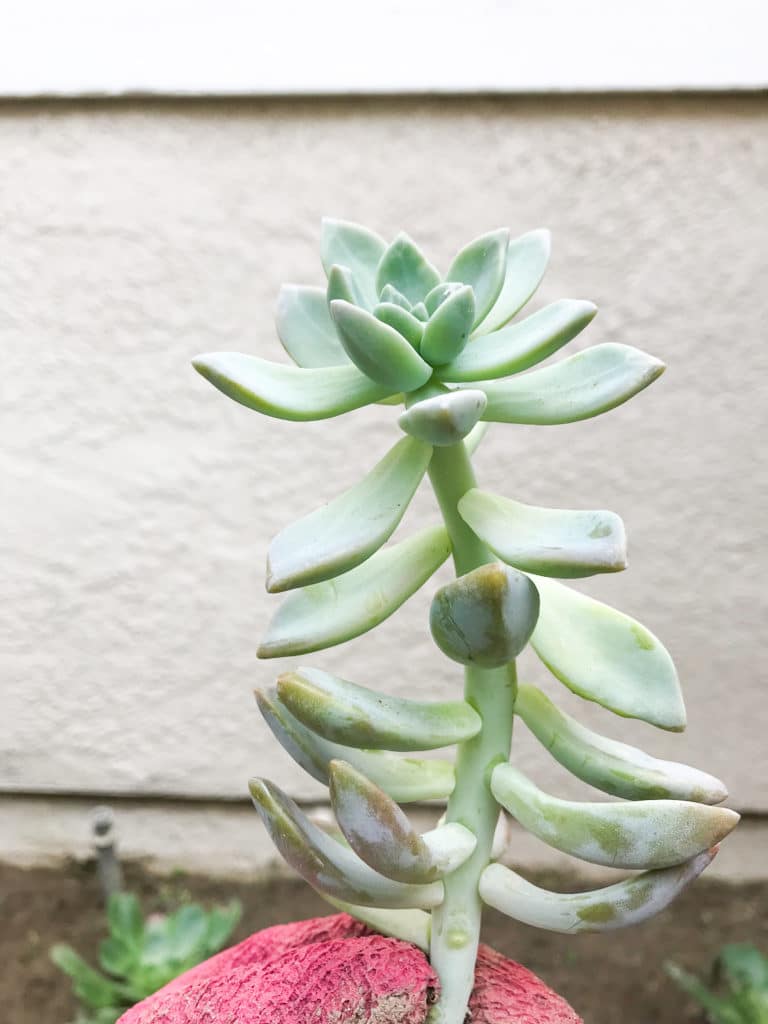
Are My Leggy and Stretch-outed Succulents Going to Die?
Your succulent isn’t going to die just because it grew leggy or changed its compact shape. It’s likely a healthy plant that’ll continue to grow well in a brighter location.
Your plant is simply showing signs that it needs to be moved to a sunnier area of your home or garden. Try moving the pot or replanting to an area that gets more access to light to prevent your plant from continuing to stretch out.
If you don’t move it to a sunnier spot and leave it in the shade for too long a period, then yes, your succulent might eventually give out and die because it’s not getting one of the most vital things it needs to survive.
Don’t worry, though, this is the worst-case scenario and it wouldn’t happen right away. Remember, succulents are hardy plants that do their very best to survive.
Also, make sure you’re rotating your pots to ensure that all succulents are getting access to light.
Sometimes it’s difficult for a shorter succulent to get the light it needs if it’s placed next to or below a taller succulent that’s blocking the light source.
This applies to succulents planted in the ground, too, that can be blocked by other plants.
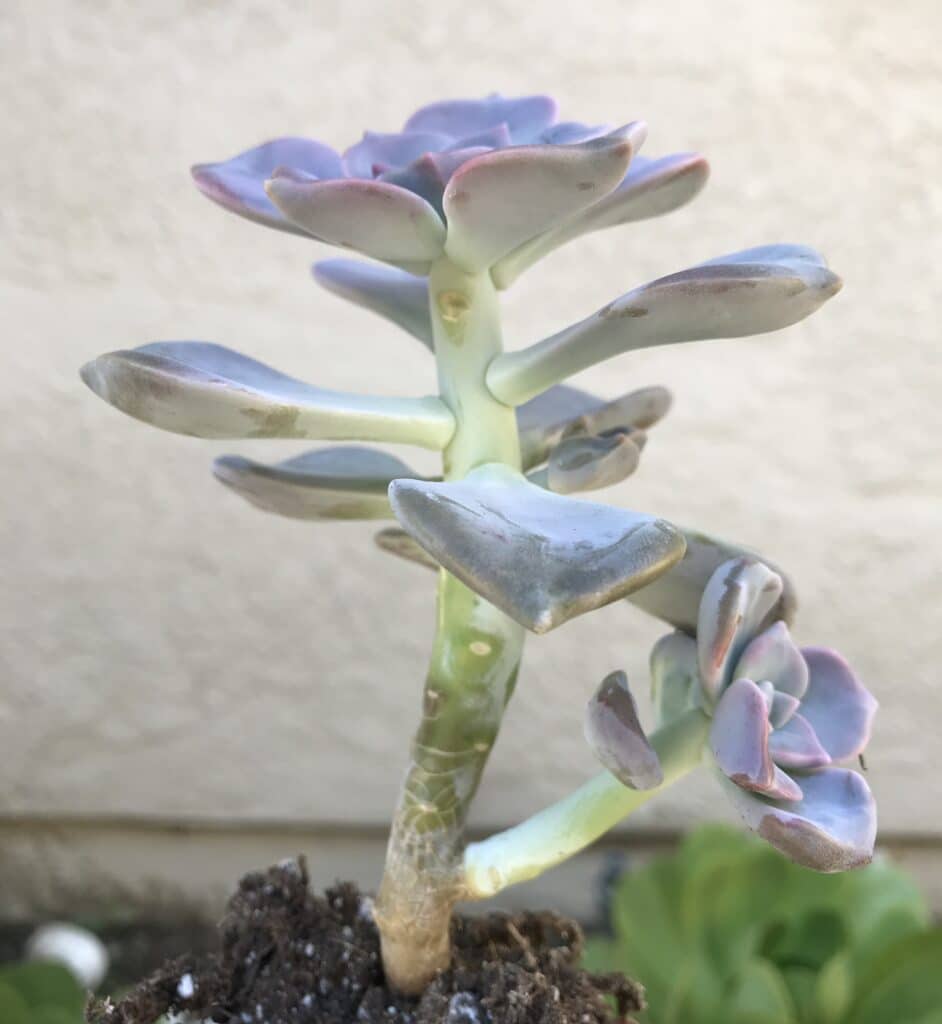
Also, make sure you’re rotating your pots to ensure that all succulents are getting access to light.
Sometimes it’s difficult for a shorter succulent to get the light it needs if it’s placed next to or below a taller succulent that’s blocking the light source.
This applies to succulents planted in the ground, too, that can be blocked by other plants.
Prevent Leggy Succulents with Lots of Light
How much sunlight do succulents need? It’s a popular question.
Succulents love the sun, but they’re also susceptible to sunburn in extreme temperatures (usually 90 degrees Fahrenheit and above). Some succulent types need more sunlight than others. And some do very well in low-light.
Generally, though, succulents need about 6 hours of sunlight each day.
Indirect sunlight can prove to be best during the summer because high temperatures can quickly scorch the leaves of succulents.
Only a few succulents do well in full sun during the heat of summer. Most of them will burn, and even the toughest ones will experience some sunburns here and there.
But if you want to prevent succulent stretching as much as possible, then direct sunlight is what they need; it’s a simple solution.
Leave them out in the sun for most of the year but take precautions during the summer to help them survive.
These precautions include watering in the morning when the top of the soil is dry and providing shade if possible. Don’t let the soil go dry for long – especially with new plants.
For healthy leaves, you need to water the soil often during the hottest months of the year. In my area, this means every morning.
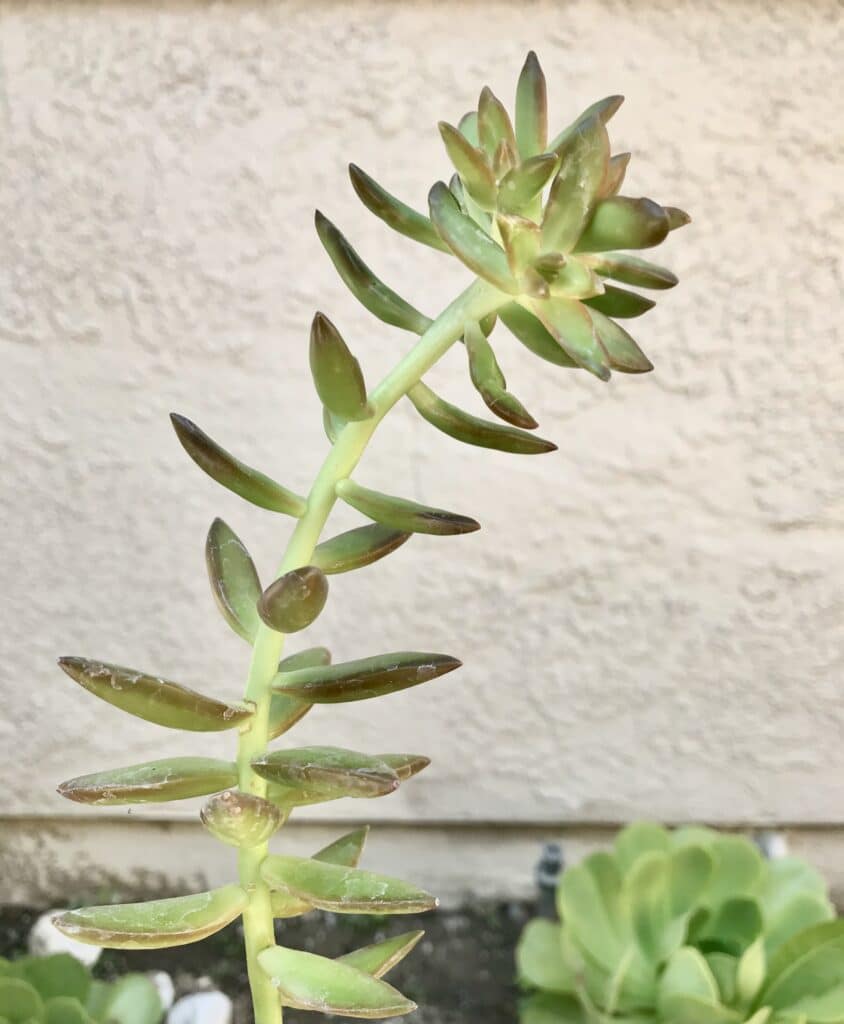
If you need to grow your succulents indoors, though, the best thing to do is place your plants near a window that gets good sunlight exposure.
The more sun the better because sunlight is what prevents leggy stems and weak growth. It’s also why they are better as outdoor succulents than indoor succulents.
Place your succulent planters on a dining table (like I did with my succulent Christmas centerpiece), an end table, a coffee table, a kitchen counter, and even on the floor, as long as it gets access to bright light.
What Can I Do to Fix Succulents that Grow Leggy?
It’s disheartening that once a succulent stretches out, it can never go back to its former shape. You can, however, use it for propagation! A stretched-out succulent is perfect for propagation.
If you’re not pleased with your leggy or stretched-out succulent, you can try your hand at leaf propagation.
This way, you’ll make use of the succulent you paid good money for and you’ll also multiply your collection without having to spend extra money!
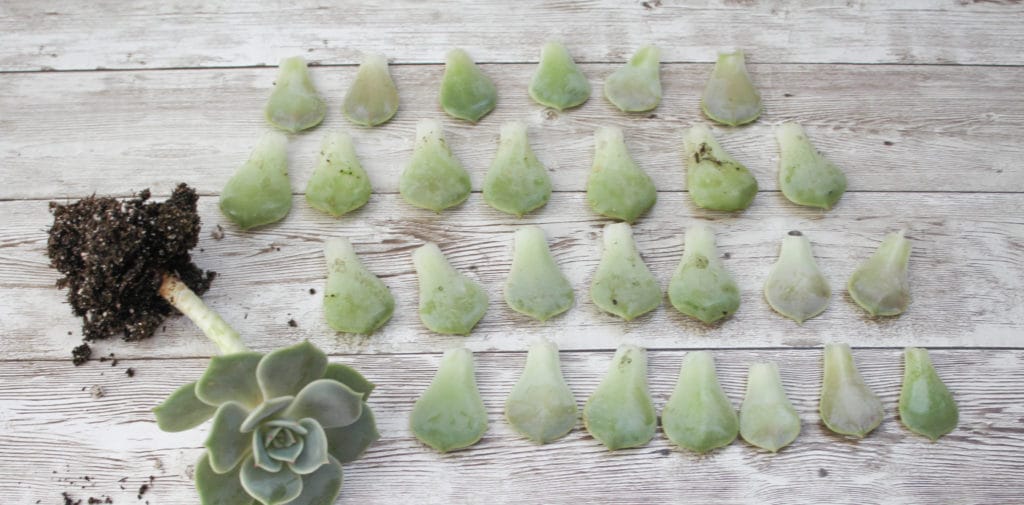
I have an in-depth post about propagating succulents, here, but I’ll give you the super-simple version, below:
- Remove your succulent from its pot or out of the ground
2. Gently tear each leaf off of the stem, making a clean cut. You want your succulent to look like the photo below.
See how it’s a straight line without any jagged edges? This is what you need to aim for, otherwise, the leaf will never grow roots.
3. Set the leaves aside and keep them out of direct sunlight so that the ends of the leaves can callus over in a few days
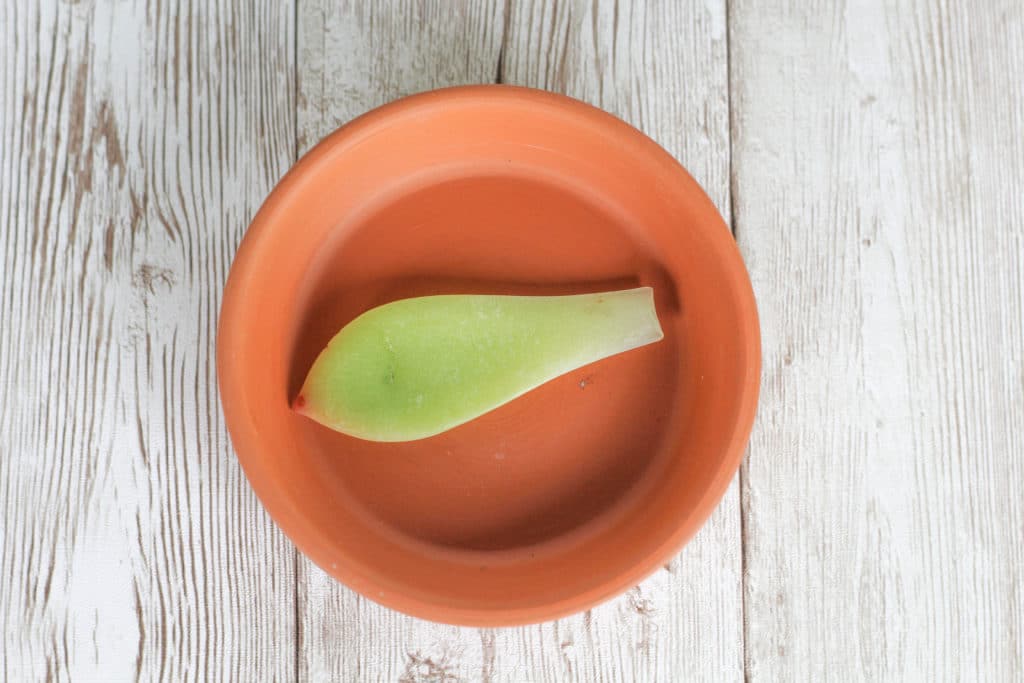
4. Once calluses have formed, place the leaves on top of a tray of soil, not in the soil.
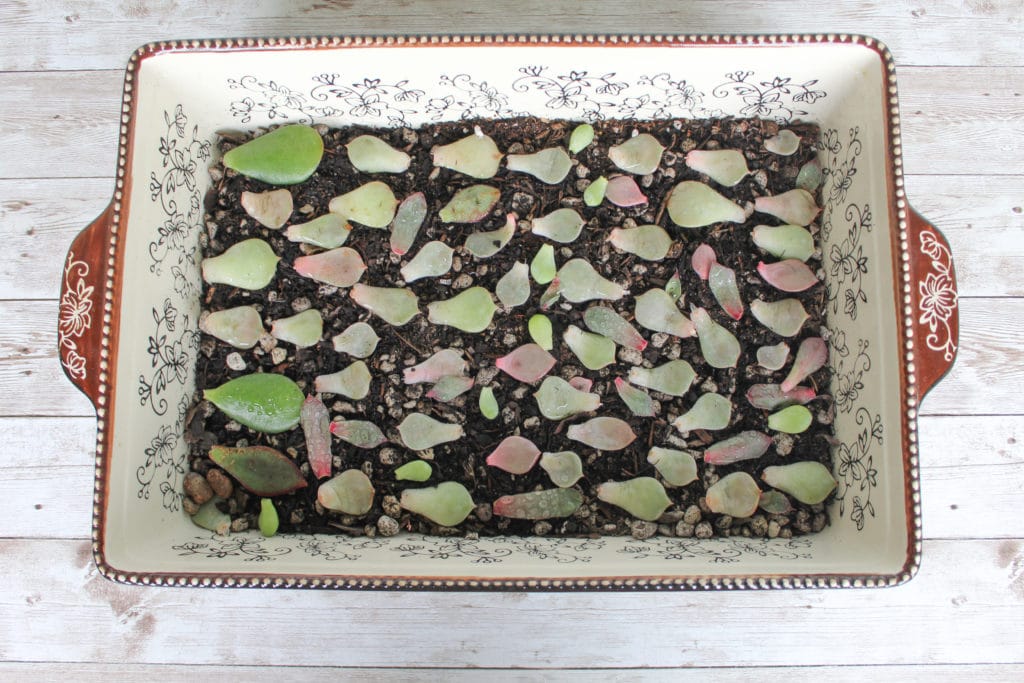
5. Spritze the leaves with water every day or every few days. In a few weeks’ time, roots will start to grow from the end of the leaves.
In a few more weeks, you should start to see succulent babies form out of those roots. They’ll look like little replicas of the parent succulent.
Once the succulent baby is about a quarter large, plant it in a small pot as you would any other succulent and voila – you just successfully propagated a succulent!
Important notes: Not all leaves will form roots, so don’t worry if they don’t. Also, not all leaves that form roots will sprout a succulent baby. That’s ok, too. Simply discard the leaves if they don’t end up performing. I usually have about a 60% success rate with the leaves I do propagate, which I think is pretty good!
I’ve also had success with simply setting leaves aside (away from direct sunlight) and letting them do their thing without any help from me.
Many of them did grow roots and succulent babies! It’s pretty miraculous.
Propagation is one of my favorite things to do in the garden. It’s an easy process, and it’s perfect for those who love having something to nurture and care for!
So please don’t let your stretched-out and leggy succulents stress you out- it happens to everyone at some point!
Just know you have two options when etiolation happens: you can either learn to love your plant’s new shape OR you can create tiny plants from that single succulent. No losses there!
For more on succulents, give my How to Care for Succulents post a quick read!
WANT TO REMEMBER THIS POST ABOUT LEGGY SUCCULENTS? SAVE IT TO YOUR FAVORITE PINTEREST BOARD!

WANT TO LEARN MORE ABOUT SUCCULENT CARE?
Check out the posts below for more information on growing healthy succulents!
The Best Succulents Plants for Indoors
DIY Side Yard Ideas for Transforming a Small Space
Best Succulent for Full Sun
How to Save an Overwatered Succulent
DIY Succulent Arrangements: Fun and Easy Ideas for Your Home
How to Water Succulents – the Right Way
Do Succulents Die After Flowering?
How to Make Your Own Succulent Soil
How to Care for Hens and Chicks Succulents
Succulent Leaves Falling Off When Touched: Top Causes and Solutions
Growing String of Bananas: Plant Care Guide
What’s Wrong with My Succulents? Common Problems and Solutions